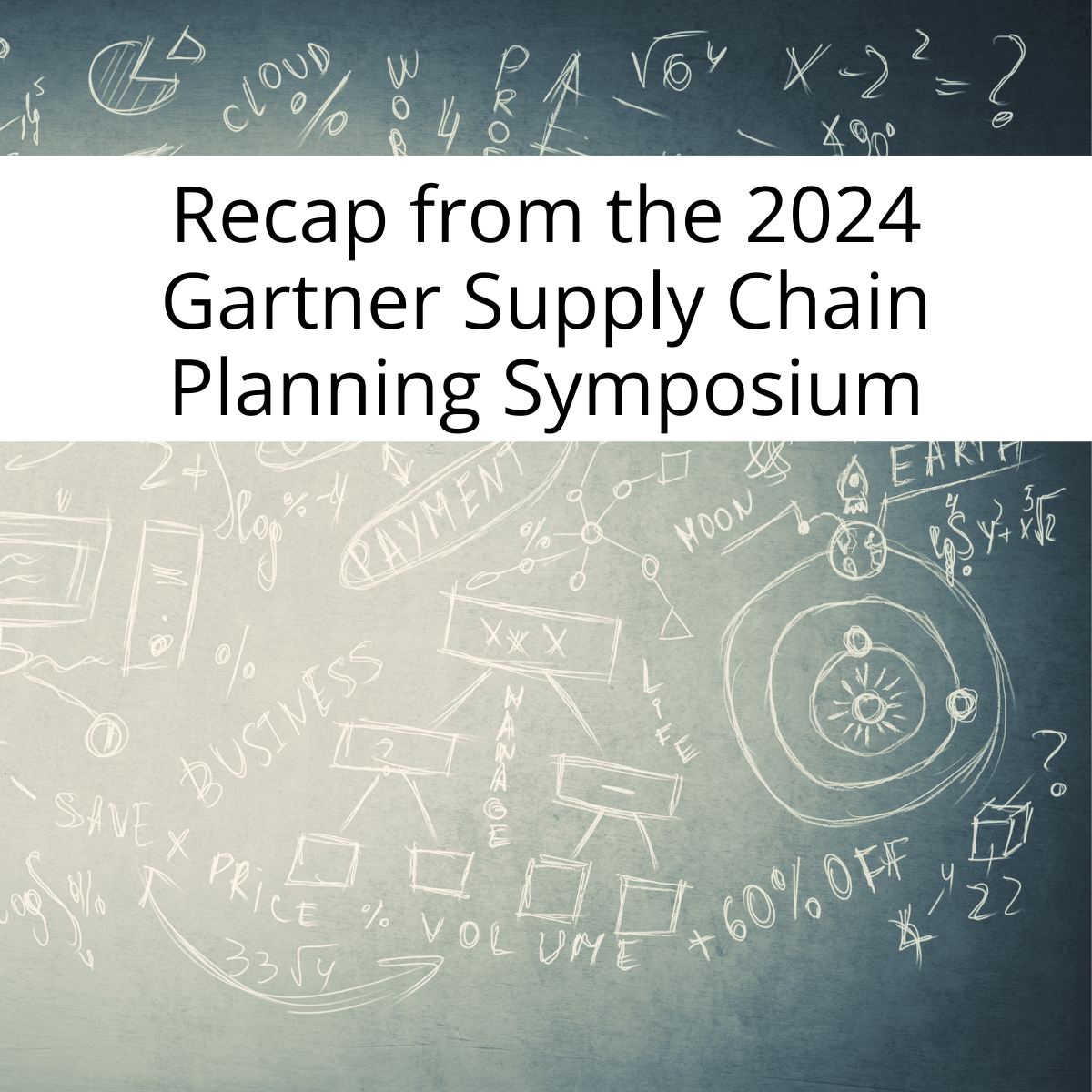Recapping the 2024 Gartner Supply Chain Symposium:
In a world where the complexity and uncertainty of supply chains continue to escalate, the ability to make high-quality and timely decisions has never been more critical. At the recent Gartner Supply Chain Symposium/Xpo™ ( May 6th-8th) in Orlando, GAINS’ VP of Industry Solutions Amber Salley presented an enlightening session entitled “Improved Decision Making Drives Superior Outcomes,” which dove deep into modern supply chain challenges and the approaches and technologies poised to address them. For those unable to attend Gartner or catch Amber’s session during the show, this blog aims to encapsulate the essence and insights of her presentation on decision engineering.
Decision Engineering for Supply Chain
At the heart of Amber’s discussion are the critical intersection of data science, decision science, decision orchestration, and distributed systems engineering and the transformative impact they can have on supply chain performance. It is the junction where artificial intelligence (AI), machine learning (ML), simulation, scenario management, and composable architecture converge to enable smarter, data-driven choices. By integrating these technologies and disciplines, businesses can anticipate supply chain network disruptions, optimize inventory levels, improve operational efficiency, and positively impact EBITDA and fuel growth. Amber emphasizes that the key to leveraging these advances lies in understanding the unique challenges and opportunities of each supply chain. This approach facilitates informed decisions and enhances responsiveness to market changes and consumer demands, leading to more agile supply chains.
One of the focal points of Amber’s presentation was the concept of decision engineering as it relates to effective supply chain management. The GAINS approach underscores the importance of integrating decision science, data science, distributed technology systems, and decision orchestration to enhance decision-making. In essence, decision engineering empowers organizations to make better decisions and achieve higher-quality outcomes by aligning strategic and operational decisions across time horizons. This alignment is pivotal in navigating the complexities of interconnected supply chains operating in a VUCA environment, enabling supply chain teams to plan more effectively.
Beyond Supply Chain Resiliency to Anti-Fragility
Amber also discussed the concepts of anti-fragility versus resiliency within supply chain management. Resiliency bounces back from disruptions, whereas anti-fragility is about thriving amidst chaos. By adopting an anti-fragile approach, organizations can modify their supply chain planning and design activities to better adapt to and benefit from uncertainty. Just as fire drills ensure readiness for an unforeseen fire, anti-fragile strategies prepare supply chains for unexpected disruptions from external factors. This concept is becoming increasingly relevant as supply chain disruptions such as natural disasters, interruptions to product flow, and delivery of products continue to escalate in frequency and severity.
Gartner analyst Tom Enright’s keynote address that kicked off the Gartner Supply Chain Symposium/Xpo focused on this very topic of antifragile supply chains, with the following being one of his key takeaways:
“Leading supply chain organizations are adopting antifragile capabilities that go beyond resilience and deliver value in uncertain environments.”
Composability: The Future of Supply Chain Solutions
A significant highlight of Amber’s session was the concept of composability in supply chain solutions. Composability allows organizations to assemble (and disassemble) various services to create customized workflows tailored to their specific needs. This model offers unprecedented flexibility for companies. By moving away from monolithic software solutions and towards a composable environment, organizations can leverage “a la carte” supply chain services without being tied down by rigid, one-size-fits-all systems. This approach is especially beneficial for organizations looking to scale their supply chain operations and adapt quickly to changing market conditions in a competitive landscape.
GAINS has commenced a platform modernization strategy to offer a fully composable, services-oriented architecture for supply chains. The new platform provides independent services to supply chain planning and design capabilities, such as GAINS lead time prediction service.
Building an Ecosystem of Technologies
Amber emphasized the critical role of establishing an ecosystem of technologies to support an antifragile supply chain network. She shared the GAINS view that a supply chain technology environment that supports anti-fragility will be heterogeneous and hybrid, requiring an ecosystem of partners to build, deploy, and maintain supply chain systems. In this ecosystem, technology vendors play a crucial part by offering specialized services and connectors that integrate seamlessly with existing systems. Such an ecosystem facilitates a holistic and integrated approach to supply chain performance management, enabling organizations to leverage the best design and planning tools and services available in the market, thus gaining a competitive advantage by driving superior outcomes.
Aggregating and normalizing data from diverse sources is a massive challenge for ecosystem synchronization. This is crucial for gaining valuable insights, and the GAINS Connect API solution is designed to handle it. Supply chain managers need access to a comprehensive view of their operations and the ability to analyze data across the ecosystem of technologies to identify patterns, trends, and potential disruptions before they occur.
Breaking Free from Outdated Practices: Embracing Modern Techniques
Supply chain professionals working today are often constrained by old business methods, relying on 20th-century technologies to solve 21st-century problems. This reliance on outdated systems is a self-imposed artificial constraint perpetuated by the desire to conduct “business as usual” due to the familiar comfort of “the way we have always done it.”
Many companies continue to design and manage their supply chains using best-in-class methods. Regrettably, these best-in-class methods were developed decades ago when supply chains had more predictability and when computer systems were severely limited (compared to today). The result is that the supply chain methods supply chains are deploying are not sufficient to manage growing complexity and uncertainty. As they deployed technology to improve outcomes, those technologies were purpose-built to support the outdated best-in-class methods. Companies will spend excessive money to maintain an obsolete and inefficient system rife with workarounds because of the time, effort, and money previously invested. This ultimately leads to lower-quality decisions and suboptimal supply chain results.
When companies apply decision engineering principles, they move from a process focus aligned with time horizons to a decision outcome focus. They evolve from deterministic to stochastic planning approaches and move away from one-number plans to performance ranges. They start to understand the cause and effect of their decisions. They also extend the trade-off analysis to include finance, service, sustainability, agility, and resilience performance.
Common Barriers Caused by Outdated Practices
Supply Chain Professionals need to recognize that outdated methods and systems are potentially holding them back and that their true potential for creating higher-quality decisions and improving supply chain productivity lies in embracing new, composable solutions that leverage advanced analytics, AI/ML simulation, scenario management on a composable platform that supports decision orchestration across all time horizons.
These barriers can manifest in several ways:
- Poor Decision-Making: Decision-making in supply chain management is becoming increasingly complex, requiring the ability to analyze vast amounts of data quickly. Outdated systems lack the advanced analytics capabilities to process and interpret data in real-time, leading to slower and less accurate decisions.
- Increased Risk Exposure: In a VUCA (Volatile, Uncertain, Complex, Ambiguous) world, businesses need to be agile and resilient. Outdated methods and systems are often less adaptable to sudden changes or disruptions, increasing the risk of significant operational setbacks
- Limited Scalability: Traditional methods and systems are often rigid and challenging to scale. As companies grow organically or through acquisition, their supply chain needs evolve, requiring systems that can adapt and expand without involving IT resources.
- Operational Inefficiencies: Typically stemming from the need for manual intervention on behalf of supply chain practitioners, standard technologies used to support planning and design (such as spreadsheets or ERPs) can create operational bottlenecks, leading to delays, errors, and increased costs. Typically, these inefficiencies cascade through the supply chain, affecting everything from procurement to delivery and ultimately impacting customer satisfaction and the bottom line.
Embracing Advanced Solutions to Enable Decision Engineering
By transitioning to decision engineering supported by composable, advanced solutions, like GAINS, companies can unlock numerous benefits:
- Enhanced Analytics: allows companies to gain deeper insights into their operations, forecast demand more accurately, optimize inventory levels, and identify potential disruptions before they occur.
- Greater Agility: Modern supply chain solutions can adapt to changing business needs and market conditions, allowing companies to respond quickly to new opportunities and challenges.
- Risk Management: Advanced scenario planning and real-time monitoring solutions help companies develop more robust contingency plans and respond proactively to disruptions.
- Artificial Intelligence and Machine Learning: AI and ML can automate routine tasks, improve forecasting accuracy, and provide actionable insights.
A Call to Rethink Supply Chain Strategies
Amber Salley’s presentation at the 2024 Gartner Supply Chain Symposium articulated the need for a new way of thinking about supply chain planning and decision-making. Organizations can significantly improve their decisions, increase operational efficiency, and drive superior outcomes by harnessing the principles of decision engineering, adopting an antifragile mindset, and utilizing composability as part of a well-designed supply chain management process—one that is ready for all the disruptions being thrown at supply chains every day.
Stay attuned to the GAINS blog and podcast for more insights into GAINS methods and ideology. Explore Amber’s other blogs, listen to her podcasts, and consider a new composable way of thinking when searching for solutions that break conventional bounds in supply chain digital transformation. Together, we can redefine the supply chain management landscape and set new benchmarks for success in this rapidly evolving field.
In conclusion, the time for change is now. Supply chain professionals must break free from the constraints of outdated practices and technologies. GAINS offers the tools, expertise, and support needed to transition to modern, efficient, and effective supply chain solutions. By doing so, businesses can survive and thrive in the face of 21st-century challenges.
More Thought Leadership from Amber Salley
Amber Salley is a renowned expert in supply chain planning who continually provides thought leadership to supply chain managers and leaders across the industry in her role at GAINS. Her expertise goes beyond traditional approaches, as she regularly challenges conventional thinking and offers deep understanding and fresh perspectives that drive transformative change, helping businesses achieve their strategic objectives. Amber has authored several articles and given numerous presentations that delve deeper into the intricacies of GAINS’s forward-looking process. Amber provides detailed insights into current and future trends, emerging technologies, and innovative strategies to optimize your supply chain organization. Read more from Amber below.
Follow GAINS and Amber Salley on LinkedIn.
Additional Resources
SCMR: Talking Supply Chain with Amber Salley
Blog: Five Questions with a Supply Chain Expert
Blog: How GAINS Embodies ASCM’s Supply Chain Vision for 2024 by Amber Salley



